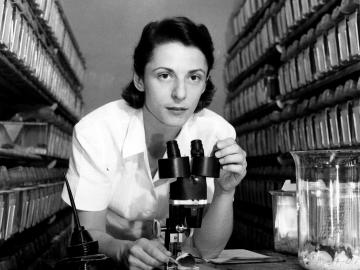
Filter News
Area of Research
- Advanced Manufacturing (3)
- Biological Systems (1)
- Biology and Environment (41)
- Computational Biology (2)
- Computational Engineering (2)
- Energy Science (39)
- Fusion and Fission (7)
- Fusion Energy (8)
- Isotopes (6)
- Materials (46)
- Materials for Computing (9)
- Mathematics (1)
- National Security (10)
- Neutron Science (121)
- Nuclear Science and Technology (16)
- Nuclear Systems Modeling, Simulation and Validation (1)
- Supercomputing (62)
News Type
News Topics
- (-) Advanced Reactors (37)
- (-) Biomedical (70)
- (-) Clean Water (32)
- (-) Coronavirus (47)
- (-) Neutron Science (163)
- (-) Summit (70)
- 3-D Printing/Advanced Manufacturing (137)
- Artificial Intelligence (127)
- Big Data (70)
- Bioenergy (109)
- Biology (126)
- Biotechnology (38)
- Buildings (65)
- Chemical Sciences (83)
- Composites (33)
- Computer Science (216)
- Critical Materials (28)
- Cybersecurity (34)
- Education (5)
- Element Discovery (1)
- Emergency (4)
- Energy Storage (107)
- Environment (202)
- Exascale Computing (65)
- Fossil Energy (8)
- Frontier (61)
- Fusion (63)
- Grid (70)
- High-Performance Computing (125)
- Hydropower (12)
- Irradiation (2)
- Isotopes (58)
- ITER (9)
- Machine Learning (64)
- Materials (147)
- Materials Science (145)
- Mathematics (11)
- Mercury (12)
- Microelectronics (4)
- Microscopy (51)
- Molten Salt (10)
- Nanotechnology (58)
- National Security (81)
- Nuclear Energy (113)
- Partnerships (68)
- Physics (64)
- Polymers (31)
- Quantum Computing (52)
- Quantum Science (89)
- Security (29)
- Simulation (61)
- Software (1)
- Space Exploration (26)
- Statistics (4)
- Transportation (92)
Media Contacts

The prospect of simulating a fusion plasma is a step closer to reality thanks to a new computational tool developed by scientists in fusion physics, computer science and mathematics at ORNL.

An international team of researchers has discovered the hydrogen atoms in a metal hydride material are much more tightly spaced than had been predicted for decades — a feature that could possibly facilitate superconductivity at or near room temperature and pressure.

Researchers have developed a new process that could make it much cheaper to produce biofuels such as ethanol from plant waste and reduce reliance on fossil fuels.

A select group gathered on the morning of Dec. 20 at the Department of Energy’s Oak Ridge National Laboratory for a symposium in honor of Liane B. Russell, the renowned ORNL mammalian geneticist who died in July.

Nuclear scientists at Oak Ridge National Laboratory have established a Nuclear Quality Assurance-1 program for a software product designed to simulate today’s commercial nuclear reactors – removing a significant barrier for industry adoption of the technology.

Researchers across the scientific spectrum crave data, as it is essential to understanding the natural world and, by extension, accelerating scientific progress.

For nearly three decades, scientists and engineers across the globe have worked on the Square Kilometre Array (SKA), a project focused on designing and building the world’s largest radio telescope. Although the SKA will collect enormous amounts of precise astronomical data in record time, scientific breakthroughs will only be possible with systems able to efficiently process that data.

Illustration of the optimized zeolite catalyst, or NbAlS-1, which enables a highly efficient chemical reaction to create butene, a renewable source of energy, without expending high amounts of energy for the conversion. Credit: Jill Hemman, Oak Ridge National Laboratory/U.S. Dept. of Energy

While Tsouris’ water research is diverse in scope, its fundamentals are based on basic science principles that remain largely unchanged, particularly in a mature field like chemical engineering.

As scientists study approaches to best sustain a fusion reactor, a team led by Oak Ridge National Laboratory investigated injecting shattered argon pellets into a super-hot plasma, when needed, to protect the reactor’s interior wall from high-energy runaway electrons.


